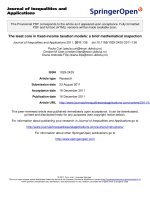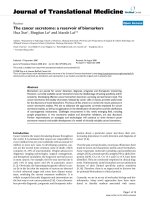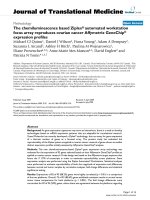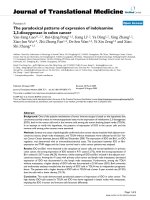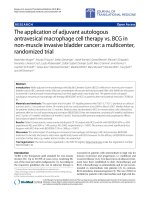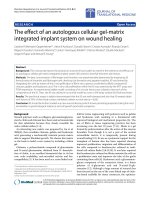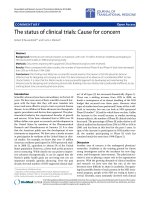Báo cáo hóa học: " The Common Agricultural Policy vis-à-vis European pastoralists: principles and practices" ppt
Bạn đang xem bản rút gọn của tài liệu. Xem và tải ngay bản đầy đủ của tài liệu tại đây (177.7 KB, 8 trang )
SHOR T REPOR T Open Access
The Common Agricultural Policy vis-à-vis
European pastoralists: principles and practices
Silvia Nori
*
and Michele Gemini
* Correspondence:
via casine, 10 - Firenze, Italy
Abstract
This article reviews how the European Union Common Agricultural Policy (CAP)
currently addresses pastoralists’ needs in Europe, and could further contribute to
sustainable management of pastoral areas. The CAP provides a set of financial
subsidies to farmers in the form of market, income and rural development support.
We first present a brief overview of the CAP, its basic principles, the available
instruments, recent developments and finally discuss the future challenges and
potentials for pastoralists in the European Union.
Keywords: Common Agricultural Policy, Europ ean Union, pastoralism
Introducing pastoralism and the Common Agricultural Policy
Pastoralism is being increasingly appreciated worldwide as an environmentally friendly
practice, which, in the European Union (EU) is valued as particularly important for the
protection and the safeguarding of mountainous areas, defined as ‘Europe’s ecol ogical
backbone’ (European Environment Agency 2010).
Appropriate pastoral resource management is recognised as favourable for the envir-
onment due to a number of reasons, which include:
• enhanced conservation of plant and animal biodiversity (UN 2010),
• sustainable land and water management by supporting the active management of
vegetation cover reducing soil erosion, flooding and fire hazards, by facilitating
water flow and retention, and
• important carbon sink capacities, since properly managed grasslands store
appr oximately 34% of the glob al stock of CO
2
). If the grassland becomes degrade d
or is converted to croplan d, it loses some of its capaci ty to store this carbon (FAO
2006,; WB, 2009).
Thus, pastoral resource management holds the potential to contribute to carbon
sequestration, biodiversity protection and soil and water conservation by h elping to
maintain the grasslands - as also recognised by three UN Environmental Conventions -
biodiversity, desertification and climate change. In practice, matters are more contro-
versial, as t he scale, intensity and distribution of ecolo gical impacts of an economic
activity vary depending on differing physical, economic and social circumstances, on
the decisions made by individual farmers and on the complexity of linkages between
Nori and Gemini Pastoralism: Research, Policy and Practice 2011, 1:27
/>© 2011 Nori and Gemini; licensee Springer. This is an Open Access article distributed under the terms of the Creative Commons
Attribution License ( which permits unrestricted use, distribution, and reproduction in
any medium, provided the original work is properly cited.
agricultural actions and environmental outcomes (EC 2006a). Experience attests that
different dynamics in pastoral areas might give different environmen tal outcomes. For
example, less intense land use and a certain degree of land abandonment in given
are as can give rise to positive environmental impacts by reducing press ure on soil, air
and water resources and increasing biodiversity. On the other hand, large reductions in
grazing pressure or the complete cessation of grazing can give rise to changes in vege-
tation that result in reduced habitat and species diversity.
Extensive livestock systems and pastoralism represent increasingly interesting prac-
tices for the Common Agricultural Policy (CAP), the policy of the European Commis-
sion that promotes sustainable agriculture in a global environment through a number
of support programmes as well as subsidy schemes. Since coming into operation, the
overall aim of the CAP is to provide European farmers with a reasonable standard of
living, consumers with quality food at fair prices and to maintain farming in all regions
of the EU. The CAP represents an important financial engagement from the EU
towards its countryside, and involves about 42% of the overall EU budget for 2011
(141. 2 billion euros). There is little doubt th at any other sector in the EU has received
as much sustained support as agriculture since the end of World War II.
Since 1975, the designation of Less-Favoured Areas (LFAs) within the CAP recog-
nises the specific features of areas presenting agro-ecological constraints (lack of water,
climat e, unfavourable soil and terrain characteristics, short crop season and tendenci es
of depopulation), including mountai nous or hilly features. However, pastorali sm in the
EU is mostly associated with mountainous ecosystems ar eas which exist in southern as
well as in northern Europe, where mobile livestock rearing is also practiced outside
mountainous environments. LFAs benefit from di fferent forms of compensatory allow-
ances, i.e. the LFA pay ments - now called Natural Handicap Payments, and from a
number of payments for structural adjustm ent. Such areas, indicated in the EU policy,
are designated by national governments.
An important principle underpinning the CAP is that of subsidiarity, meaning that
different institutional levels play diverse and complementary roles, and the central
authority should have a subsidiary function, performi ng only those tasks which cannot
be performed effectively at a more immediate or local level (typically the national and
the regional levels). EU agricultural policy frames the general guidelines aimed at sup -
porting and improving agricultural prod uction - but then the detailed implementation
of the s cheme varies in different member countries of t he EU. Within this framew ork,
the extension and veterinary services addressing the needs and interests of livestock
herders - pastoralists - are dealt with at national level.
The design and functioning of the CAP
In the recent decade, the CAP has undergone revisions and reforms, redesigning the
framework regulating agricultural production and countryside manage ment. Since the
2003 reform, more emphasis is allocated to environmental quality, food safety and ani-
mal welfare (Cooper et al. 2009). Through a prin ciple named ‘decoupling’,EUfunding
support is partially detached from production (crop or livestock head) and instead
towards promoting more environmentally friendly practices. Also in line with World
Trade Organization (WTO) regulations, the aim of decoupling is to let the agricultural
sector shift towards more market-based dynamics. Therefore, public financial support
Nori and Gemini Pastoralism: Research, Policy and Practice 2011, 1:27
/>Page 2 of 8
more directly relates to the proper stewardship of land and farmers’ practices are
remunerated for their capacity to deliver the basic public goods desired by European
society.
According to these principles, the CAP is currently structured around two comple-
mentary pillars: the first pillar supports market measures and annual direct payments
to farmers and is fina nced through annual payments f rom the budget of the EC. The
second pillar supports farmers’ initiatives and multi-annual rural development mea-
sures, which include environmental protection. The budget for these measures comes
from programmes co-financed by the Member States. According to the principle of
subsidiarity such measures are then differentially applied in the individual Member
States.
The main aim of the first pillar through the direct payment scheme is to guarantee
farmers more stable incomes, by providing remuneration related to the land area man-
aged through farming practices; it is thus an area-based mechanism. For European pas-
toralists this means that they receive financial support related to the amount of the
land they manage - rather than per head of anima l kept, as it was the case until about
2003, when WTO regulations ruled out this arrangement. These mechanisms are
intended to provide a basic level of support to maintain farming activity across the EU,
to ensure a mi nimum level of maintenance to lands receiving payments, and to moni-
tor and prevent significant declines in permanent pastures.
A main concern for European pastoralists in this pillar relates to the classification of
land and thus their eligibility for CAP subsidy schemes. The Integrated Administration
and Control System undertakes land categorisation and controls compliance with EU
regulations. In order to benefit from CAP subsidies, a land area must be identified in
the IACS system. Pastoralists’ associations as well as environmental organisations claim
that important portions of pastoral lands
a
are not classified as eligible for CAP pay-
ments a nd therefore the livestock owners who manage these lands cannot receive the
relevant CAP support.
The current debate on CAP reform addresses the issue of better support targeting.
Adaptations of the first pillar direct payment scheme should tackle the different eco-
nomic and natural conditions that f armers are facing across the EU, which advocates
for a more equitable distribution of direct financial support. What is envisaged is pro-
motion of sustainable development of agriculture in areas with specific natural con-
straints, by providing farmers in such areas an additional, c omplementary income
support in the form of an area-based payment.
The second pillar refers to measures pursuing the EU rural development policy and
its implementing tool, the European Agricultural Fund for Rural Development. The
objectives of this second pillar are in t hree main axes
b
through which financial
resources are allocated.
1. Improving the co mpeti tiveness of the farm and f orestry sector t hrough support
for restructuring, development and innovation.
2. Improvement of the environment and the countryside through support for land
management as well as helping to fight climate change.
3. Improving the quality of life in rural areas and encouraging diversification of
economic activity.
Nori and Gemini Pastoralism: Research, Policy and Practice 2011, 1:27
/>Page 3 of 8
Through t he second axis of this pillar, farmers could receive compensation for sus-
tainable land management, for instance, putting into practice agricultural activities that
are more environmentally demanding than legally mandatory requirements. Typical
instances for pastoralists include those of High Nature Value (HNV) areas, which
mainly consist of semi-natural grasslands and are managed under farming systems
characteri sed by low stocking densi ties, low levels of a gro-ch emical inputs and ofte n
labour intensive management practices such as shepherding. Examples of HNV farm-
land are alpine meadows and pasture. These low-intensity farming systems are asso-
ciated with a high species and habitat diversity or the presence of species of European
conservation concern (EC 2006a). These areas may benefit from payments that could
either compensate for natural handicaps or remunerate for specific agro-environmental
measures.
Evolving from the classification of Less-Favoured Areas, natural handicap payments
in mountain areas and in other areas with handicaps contribute, through continued
use of agricultural land, to maintaining the countryside as well as maintaining and pro-
moting sustainable farming systems. These payments compensate for farmers’ addi-
tional costs and income foregone related to permanent handicap for agricultural
production in the area concerned. The annual payment for mounta in areas i s maxi-
mum 250 € per h ectare; higher payments may be grante d in certain areas in justified
cases.
There is also remuneration for so-called agro-environmental measures. Agriculture
and natural resource management are associated with a wide range of en vironmental
public goods and services, many of which are highly valued by society. These range
from agricultural landscapes to farmland biodiversity, to water quality, to soil function-
ality, to climate stability (i.e. carbon sequestration in the case of pastureland), to air
quality, resilience to flooding, drought and fire - as well as a diverse suite of more
social public goods, including farm animal welfare (Cooper et al. 2009). If valued,
society must therefore provide economic ince ntives to encourage rural producers to
divert their production systems from efficient productio n of farm commodities to the
provision of such public goods, such as to restore or maintain specific habitats or to
manage natural resources in a certain way which might imply extra cost, land use con-
flict or income forgone. In the case of pastoral ists, such principles might well apply to
livestock owners’ genuine interest in preserving the environment and keeping it
healthy.
Operationalizing such principles presents two challenges: (a) measuring the impact of
certain practices and (b) linking the practice to a specific impact in the field, thus
accounting for the potential effect of external impacts. In this regard, the discussion is
currently upon enhancing the result-orientation of such measures. The current
approach is based on monitoring effectiveness of a certain agricultural practice (e.g.
preserving some specific plant species in wetland are as) in order to obtain a certain
result, which is potentially beneficial to the environment (i.e. protect and/or regenerate
a certain biotope). This approach implies higher transaction costs and does not directly
provide a judgement of the effective impact on the environment.
An alternative approach that directly measures the impact on the enviro nment (e.g.
the degree of nesting of a certain bird species) is being debated as an option for the
future . With this approach, measurem ent is simpler, but the overall assessment should
Nori and Gemini Pastoralism: Research, Policy and Practice 2011, 1:27
/>Page 4 of 8
also consider the incidence of ext ernal factors, thus resulting in a simpler but less reli-
able analysis.
In addition, in the axis of the second pillar, farmers receive a financial payment
which compensates them for the respect of certain practices in protected sites in rela-
tion to the implementation of some Community policies (EC 2007,; 2009,; 2010a,;
2010b).
The Rural Development Policy also provides support through the ‘LEADER’ (Links
Between Actions for the Development of the Rural Economy) approach, promoting the
involvement of local public-private partnerships, supporting local action groups to
design and carry out local development st rategies and innovative activities for develop-
ing rural areas.
Cases of EU rural development programmes for pastoral systems
Some examples are provided to show how these mea sures are put into practice,
accounting for the specificity of defined pastoral territories. In most cases, such
schemes are tailored to traditional land use patterns and the specific local agro-ecologi-
cal as well as socio-cultural conditions.
Hexagone rural development programme - natural handicap compensation
in mountain areas, France
The Programme de Développement Rural Hexagone (2007 to 2013) (Government of
France 2007) includes specific financial support to sheep transhumant systems that
make use of mountainous resources. Such practices have a very important role in
maintaining the rural environment but have to face practical difficulties tackling the
natural handicap of mountainous territories and have to bear the costs associated with
transporting the livestock to the mountains for seasonal grazing. There might be a
number of economic drawbacks to such practices on a merely cost-benefit analysis.
The basic EU economic support due to natural handicap is increased in those cases
when shepherds decide to undertake t ranshumant livestock movements. The increase
is 10% for shepherds residing in mountainous areas and 30% for th ose residing on the
mountain ‘piémont’ (foothills), given the greater distance which has to be covered to
reach the mountainous pastures.
Agro-environmental measures for biodiversity in semi-natural grazing lands,
Sweden
In Sweden, a higher yearly livestock grazing density is required to preserve the specific
biodiversity of mountain pasturelands situated in the Less-Favoured Areas (Govern-
ment Offices of Sweden 2008). This in volves a number of practice s that are labour
demanding a nd costly for the livestock owner. The grazing animals have to be on the
mountain pastures during t he whole grazing period, while the fodder value of semi-
natural grazing land is lower compared to arable (farmed) pasture, resulting in a
reduced animal growth and thus an income forgone for the farmer. The subsidy
received by the farmer aims in this situation to covers the costs for the reduced fodder
value, for the additional grazing animals and for the longer grazing period required to
fulfil the requirements.
Labour costs for transportation and surveillance of the animals are also taken into
account. Animals must be transported up from the main farm to the mountain holding
Nori and Gemini Pastoralism: Research, Policy and Practice 2011, 1:27
/>Page 5 of 8
and the surrounding pastures in early summer and taken home again at the end of the
season. Every day, the farmer must travel from their home farm to the mountain hold-
ing in order to keep an eye on the animals grazing on summer pastures; this cost of
commuting to and from the holding is included in the calculation of the financial
support.
Thus, the level of payment for mountain pastures is therefore based on the costs of
managing the land according to biodiversity maintenance objectives - and includes
remunerations to the livestock owner for the incurred costs or foregone income.
Traditional livestock breeding scheme, Bulgaria
The recent enlargement of the EU to the 12 new accession countries (Czech Republic,
Estonia, Cyprus, Latvia, Lithuania, Hungary, Malta, Poland, Slovenia, Slovakia, Bulgaria
and Romania) has somewhat contributed in reshaping the measures specifically addres-
sing pastoral areas. In particular, Romania and Bulgaria contain significant land areas
where pastoralism is a most important live lihood system, with degrees of subsistence
(i.e. pastoral communities living directly o n what they produce). Specific measures in
these regions aim at enhancing the integration of pastoral communities into market
dyn amics, while still providing suppo rt to shepherdi ng practices that are environmen-
tally friendly.
In the example below (European Network for Rural Developme nt 2010), the Bulgar-
ian Rural Development Programme supports HNV extensive grazing systems through
payments that compensate traditional mowing, and limiting livestock density.
This programme provides financial support to pastoralists that decide to rear animals
of specified local traditional breeds, in da nger of further decline in numbers and in
some cases could be lost to farming, so to maintain biodiversity. Such practices are
also incentivised in order to preserve genetic resources which are naturally adapted to
the local and regional conditions; these have the potential to play an important role in
maintaining traditional grazing systems in mountainous and semi-mountainous areas.
The list of endangered breeds is defined, and includes cattle, buffalo, sheep, goat,
swine and horses. EU support is provided only to animals which have a ‘certificate of
origin’. In this case, payment is made by livestock unit (LU). Payments per year per LU
rates: cattle and buffalo - 200 EUR/LU; sheep and goats - 165 EUR/LU; s wine - 122
EUR/LU; horse - 200 EUR/LU.
A pilot project initially addressing Pirin and Central Balkan National Parks supports
traditional mountain pastoralism so that farmers can use customary seasonal grazing
systems, involving shepherds looking after traditional local breeds in high mountain
pastures in the summer months. This scheme also aims at promoting the use of Kara-
kachan dogs as an effici ent and environmentally friendly method of protecting grazing
livestock from attack by large carnivores (wolves, bears, jackals and lynxes).
Ox trail transna tional cooperation project
An example of a cross-border initiative that fits with pastoral concerns is the Ox Trail
project (Projekt Oxenweg; which aims at reviv ing the use as
well as the culture associated with an ancient trail used by pastoralists that crosses
central Europe. This trail was in use in the late Middle Ages to the early Modern Per-
iod to move oxen from Hungary and Transylvania to the west, to southern Germany.
Nori and Gemini Pastoralism: Research, Policy and Practice 2011, 1:27
/>Page 6 of 8
The revival of such route through a number of transnational projects aims to foster
cultural communication between European regions and t o encourage tourism. The
programme is funded through the EU Leader programme, and involves partners from
Hungary, Austria, Germany as well as from Romania and Slovakia. Pastoralism in such
cases represents an added value for local development strategies.
CAP reform an d environmental goals relevant to pastoralists
In order to respond to economic, environmental and territorial challenges, the three
main objectives for the future CAP would be viable food production, sustainable man-
agement of natural resources and climate action and a balanced territorial development
(8EC 2010c). In 2010, th e Communication of the future of the Common Agricultural
Policy was presented, as a basis for the new budgetary a nd legal framew ork for the
CAP reform envisaged for 2013.
The reform inte nds to adapt by ‘greening’ direct payments, aiming to improve the
environmental performance of the CAP. This objective could be reached through
envir onmental actions such as permanent pasture, green cover, crop rotation and eco-
logical set-aside. The requirements of Natura 2000 areas and improved elements of
good agro-ecological conditions standards could also strengthen direct payments (EC
2006b,, 2010a). The provision of additional income support to farmers in areas with
specific natural constraints as area-based payments helps to avoid land abandonment
in marginal areas while providing public goods, and would be a measure in support of
pastoralism.
Acknowledgement
We would like to thank Mr. Jean Michel Courades, officer at EC DG Agriculture, for his critical comments and helpful
review.
Disclaimer
The opinions expressed in this document reflect solely those of its authors and do not represent by any means the
opinions of the European Commission or any of its bodies.
Endnotes
a
Mostly classified as semi-natural grasslands (meaning that they have not been recently reseeded or heavily fertilised)
or rangelands (lands with several layers of vegetation: grass, undergrowth, trees)
b
Council Regulation (EC) No 1698/2005
Authors’ contributions
SN drafted the portions regarding the EU Common Agriculture Policy in general; MG has dealt with the specific
relevance of such policy in pastoral areas and has developed the case studies.
Competing interests
The authors declare that they have no competing interests.
Received: 5 May 2011 Accepted: 23 November 2011 Published: 23 November 2011
References
Cooper Tamsin, Hart Kaley, and Baldock David. 2009. Provision of public goods through agriculture in the European Union.
Report prepared for DG Agriculture and Rural Development, London: Institute for European Environment Policy. http://
www.ieep.eu/assets/457/final_pg_report.pdf.
EC European Commission. 2006a. Final report of the evaluation of the less-favoured area measure in the 25 Member States
of the European Union. EC DG AGRI. />EC European Commission. 2006b. Commission working document on Natura 2000. EC DG ENV />environment/nature/info/pubs/docs/nat2000/2002_faq_en.pdf.
EC European Commission. 2007. The habitats directive. EC DG ENV. />habitatsdirective/index_en.htm.
EC European Commission. 2009. The birds directive. EC DG ENV. />birdsdirective/index_en.htm.
EC European Commission. 2010a. The Natura 2000 network website. EC DG ENV. />natura2000/index_en.htm.
EC European Commission. 2010b. Water website. EC DG ENV. />Nori and Gemini Pastoralism: Research, Policy and Practice 2011, 1:27
/>Page 7 of 8
EC European Commission. 2010c. The CAP towards 2020: meeting the food, natural resources and territorial challenges of
the future. Communication from the Commission to the European Parliament, the Council, the European Economic and
Social Committee and the Committee of the Regions. />com2010-672_en.pdf.
European Environment Agency EEA. 2010. Report No 6 Europe’s ecological backbone: recognising the true value of our
mountains. Office for Official Publications of the European Union. />ecological-backbone/.
European Network for Rural Development. 2010. Thematic working group 3. Public goods and public intervention. Final
Report. />FAO. 2006. Livestock’s long shadow: environmental issues and options. Rome: UN Food and Agriculture Organization. ftp://
ftp.fao.org/docrep/fao/010/a0701e/a0701e.pdf.
Government of France. 2007. Programme de Développement Rural Hexagonal, 2007-2013. Ministère de l’Alimentation de
l’Agriculture et de la Pêche. />2520Vdef.pdf.
Government Offices of Sweden. 2008. The European Agricultural Fund for Rural Development: Europe investing in rural
areas. The Swedish Ministry of Agriculture Rural Development Programme for Sweden. Article no. Jo 08.008, Stockholm.
/>UN. 2010. Convention on Biological Diversity. United Nations. />World Bank. 2009. Minding the stock. Bringing public policy to bear on livestock sector development. Report No. 44010-GLB,
Washington D.C: World Bank.
doi:10.1186/2041-7136-1-27
Cite this article as: Nori and Gemini: The Common Agricultural Policy vis-à-vis European pastoralists: principles
and practices. Pastoralism: Research, Policy and Practice 2011 1:27.
Submit your manuscript to a
journal and benefi t from:
7 Convenient online submission
7 Rigorous peer review
7 Immediate publication on acceptance
7 Open access: articles freely available online
7 High visibility within the fi eld
7 Retaining the copyright to your article
Submit your next manuscript at 7 springeropen.com
Nori and Gemini Pastoralism: Research, Policy and Practice 2011, 1:27
/>Page 8 of 8
